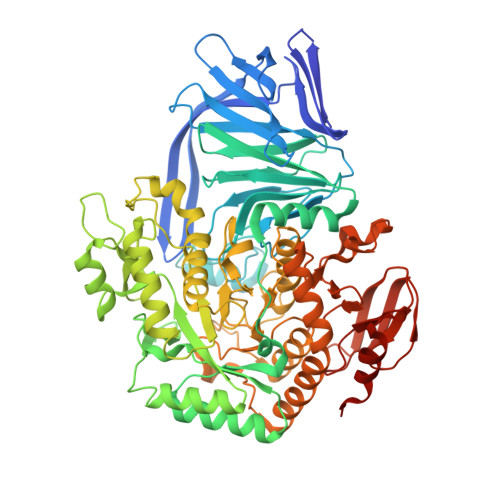Structural and Biochemical Insights into the Function and Evolution of Sulfoquinovosidases.
Abayakoon, P., Jin, Y., Lingford, J.P., Petricevic, M., John, A., Ryan, E., Wai-Ying Mui, J., Pires, D.E.V., Ascher, D.B., Davies, G.J., Goddard-Borger, E.D., Williams, S.J.(2018) ACS Cent Sci 4: 1266-1273
- PubMed: 30276262
- DOI: https://doi.org/10.1021/acscentsci.8b00453
- Primary Citation of Related Structures:
5OHS, 5OHT, 5OHY - PubMed Abstract:
An estimated 10 billion tonnes of sulfoquinovose (SQ) are produced and degraded each year. Prokaryotic sulfoglycolytic pathways catabolize sulfoquinovose (SQ) liberated from plant sulfolipid, or its delipidated form α-d-sulfoquinovosyl glycerol (SQGro), through the action of a sulfoquinovosidase (SQase), but little is known about the capacity of SQ glycosides to support growth. Structural studies of the first reported SQase ( Escherichia coli YihQ) have identified three conserved residues that are essential for substrate recognition, but crossover mutations exploring active-site residues of predicted SQases from other organisms have yielded inactive mutants casting doubt on bioinformatic functional assignment. Here, we show that SQGro can support the growth of E. coli on par with d-glucose, and that the E. coli SQase prefers the naturally occurring diastereomer of SQGro. A predicted, but divergent, SQase from Agrobacterium tumefaciens proved to have highly specific activity toward SQ glycosides, and structural, mutagenic, and bioinformatic analyses revealed the molecular coevolution of catalytically important amino acid pairs directly involved in substrate recognition, as well as structurally important pairs distal to the active site. Understanding the defining features of SQases empowers bioinformatic approaches for mapping sulfur metabolism in diverse microbial communities and sheds light on this poorly understood arm of the biosulfur cycle.
- School of Chemistry and Bio21 Molecular Science and Biotechnology Institute, University of Melbourne, Parkville, Victoria 3010, Australia.
Organizational Affiliation:


















